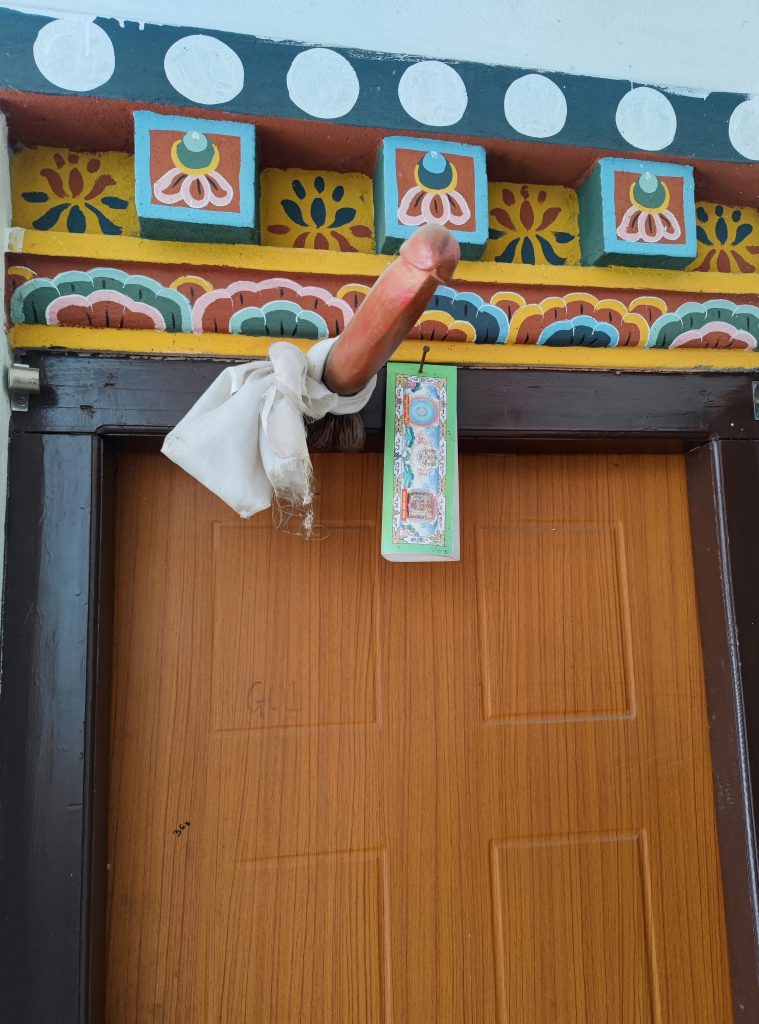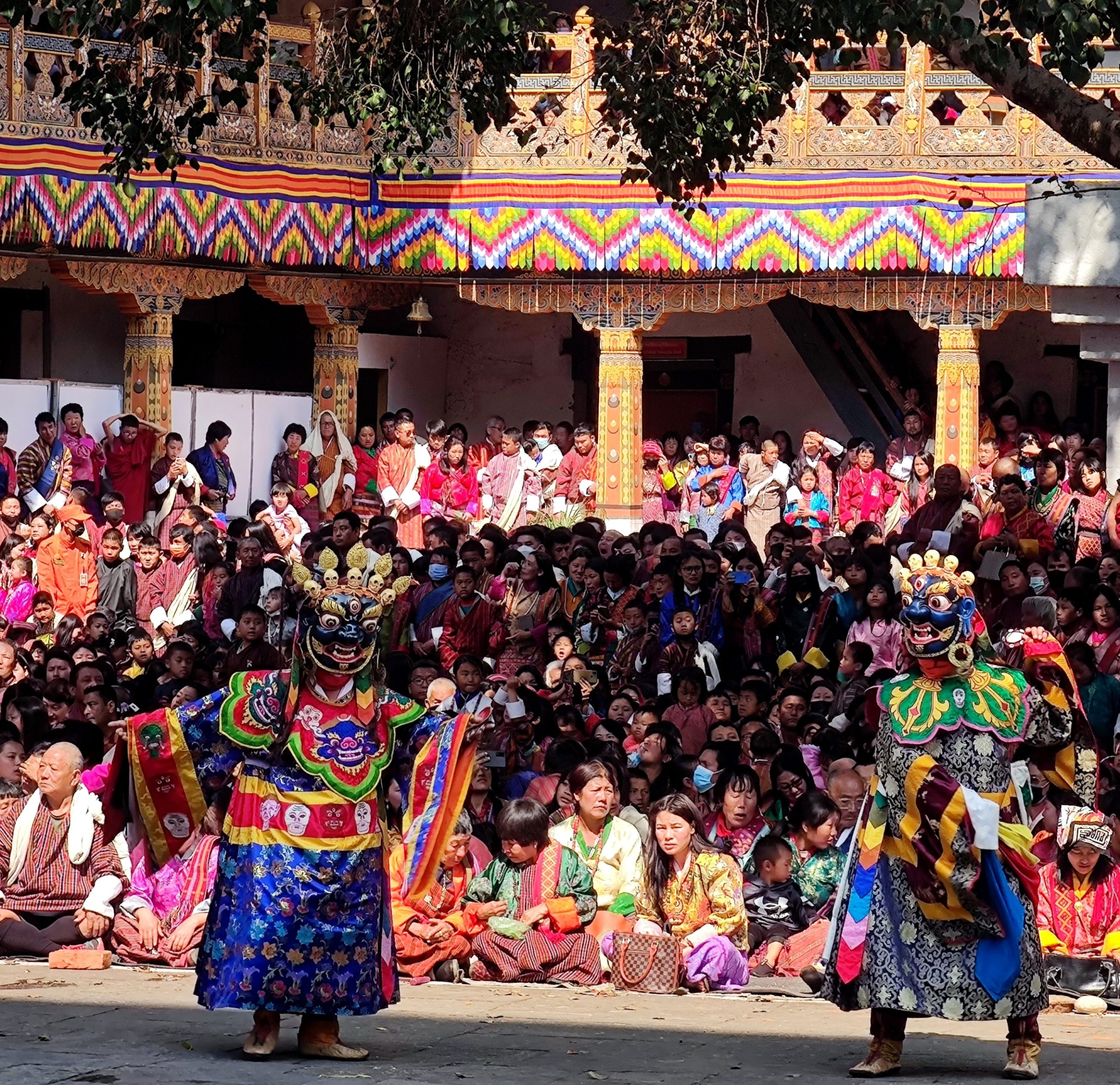
Mystical Marvels: Magical Punakha Fest – Day 3.
“If we presented you with dry facts, they’d likely slip from memory!” Our guide astutely acknowledges this truth. While others merely skim through years and histories, readily available on Wikipedia, our experience transcends the mundane. As we encircle the stupa, we also delve into the rich tapestry of stories that define the lives of the local community. These tales are not just narratives; they are living traditions passed down through generations, carrying the collective wisdom and experiences of the Bhutanese people.
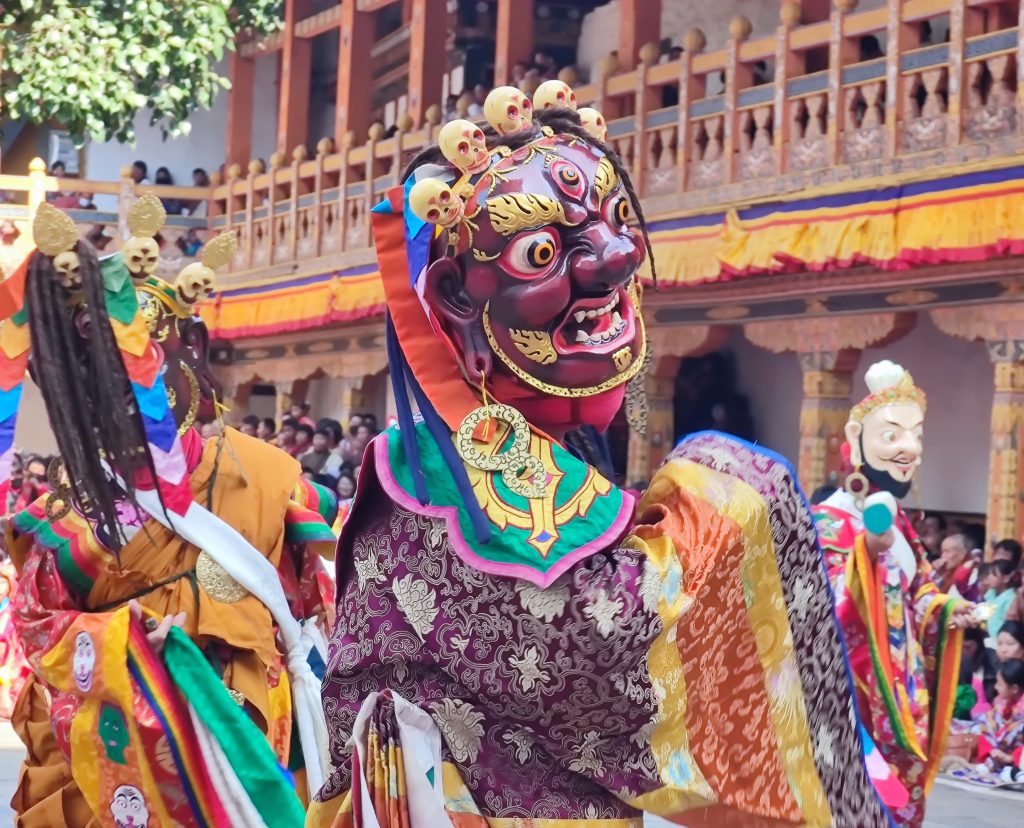
Here in Punakha, amidst lush green meadows and expansive rice terraces, two rivers elegantly meander, creating a scene straight out of a fairy tale. The locals here don’t merely encircle temples; they embark on exhilarating adventures. Rafting, hiking, cycling – these are not just pastimes; they’re a way of life. Adjacent national parks house an array of wildlife, from leopards and bears to deer and snakes.
Our stay at the hotel is unique; we’re among the select few. The guides accompanying the guests find lodging in the hotel’s attic, sharing a communal room whose sleeping arrangements remain a mystery to us. Some hotels provide accommodation for guides, while in restaurants, they are rewarded with complimentary black coffee – no sugar. In contrast to India, where tea reigns supreme, Bhutan delights in coffee, complemented by its intriguing local dishes – rice dumplings, and cheese-chili sauces.
Indeed, the practice of chewing betel nut persists in Bhutan, woven into the fabric of local traditions. The betel nut, often consumed with leaves and spices, imparts a distinctive red hue to the mouth, a visible marker of this cultural habit. Chewing betel nut is a cultural practice, introduced by a sage in the eighth century. During times of conflict when locals were engaged in warfare, the unsettling practice of consuming the flesh of those killed was not uncommon. To curb this distressing habit and satiate hunger, a Tibetan sage intervened, demonstrating the alternative of chewing the betel nut. It’s accompanied by a specific leaf and lime juice, symbolizing bones, flesh, and blood. We tried it in India briefly, but the memory of the taste is fleeting – unpleasant, akin to tobacco. Oddly enough, smoking is permissible despite common beliefs about Bhutan, as long as it’s not in public spaces. The government’s attempt to enforce this law faced challenges due to a high number of smokers, mirroring the situation with plastic usage in the country, where items are routinely served in plastic shopping bags.

Breakfast, negotiated by our guides to be included in the hotel price, inadvertently leaves them without a morning meal. Reflecting on our journey, we realize it might have been more economical to allow the guides to scout hotels rather than relying on booking websites. They have a knack for securing favorable rates and complimentary meals. We recommend, much like in India, visiting hotels in person to negotiate better prices and enhanced accommodations, a practice yielding superior rooms and significant discounts.
And here we find ourselves in the realm of “exclusive travel” – the sole option permitted in this enchanting land. Backpacker adventures are a distant dream, as the law dictates a more refined experience. It’s an intriguing paradox, given that the locals, while not affluent, must look up to wealthy foreigners. By law, these well-heeled visitors can only stay in three-star hotels, accompanied by attendants who graciously open doors and extend handshakes. A national strategy, albeit a bit unconventional. There are murmurs of reconsidering the “sustainable development fee,” as the current $200-a-day price tag may deter many. A significant drop back to $65 a day would indeed be a shock, but, as our guides opined on day one, a change in mindset is imperative. Our monetary investment, reframed as a generous donation to Bhutan, makes this the trip of a lifetime – every cent well spent, every experience savored with genuine delight.

Today’s highlight is the Punakha Dzong, nestled at the confluence of the Pho Chu (Father River) and Mo Chu (Mother River). Also known as the Palace of Great Happiness or Bliss, it is acclaimed as Bhutan’s most beautiful dzong. Constructed in 1637 by the Tibetan founder of Bhutan, Shabdrung Ngawang Namgyel, it served as the nation’s primary seat of government until the capital moved to Thimphu in 1955. In 2011, the fifth king married in this place. The dzong stands as the second oldest and second largest in Bhutan, but how did a Tibetan initiate its construction? Legend has it that an architect was chosen to sleep at the river confluence after a prophecy dictated the temple’s location. In a dream guided by a Tibetan lama, the architect glimpsed the celestial palaces and vowed to replicate the vision on Earth. The agreement was sealed. This is no ordinary fortress; it is the abode of heavenly honor!
Here, locals adhere not only to traditional attire but also to a symbolic scarf. White signifies the common man, orange designates ministers, yellow is reserved for the king, green distinguishes judges, and blue denotes election candidates. Each scarf must be worn in a specific manner, showcasing one’s status. Women, too, wear smaller, vibrant scarves. However, with a festival in full swing, the locals don festive attire, and their eyes sparkle with radiance!
Our initial plan to circumnavigate the dzong is thwarted by the vigilant guard, deeming the territory protected. As our guide says, circling larger spaces requires only a single round, while smaller ones necessitate at least three circuits. But not today! Foreigners must bide their time until nine, when the ticket office opens to collect the substantial entrance fee. Locals, on the other hand, enjoy unrestricted access. While we wait, we cross a long metal bridge over the Father River, adorned with colorful Buddhist prayer flags. At 180 meters, it claims the title of Bhutan’s longest suspension bridge. Yet, caution is advised, as some stones along the fortress are believed to house gods. A step on such sacred ground may leave an indelible scar.

Further along the path lies a crematorium, where locals practice cremation rather than burial. Intriguing rituals unfold 49 days after death, as the soul, unaware of its departure from the human body, returns home. In the crematorium, a ceremonial scarf is used and thrown into the fire as part of the ritual. Over the ensuing 49 days, more than 13 dishes are presented to the departed, and the soul is delicately fed by hand, hastening its transition. Spiritual individuals grasp their new reality faster, while others require the full 49 days.
As we approach the long bridge, traversed not only by pedestrians but also by dogs and occasional cows, we marvel at the narrow passage. Free-roaming cows, a familiar sight from India, wander openly, yet they belong to someone. They do not scavenge for food and avoid consuming garbage which contributes to a different scene than one might not expect here.
Colorful locals cross our path, often hailing from various parts of Bhutan, offering diverse perspectives. Bhutan’s unique geography and historical challenges have fostered distinct local cultures, with almost every village boasting a slightly different language. Traditional clothing, designed for Bhutan’s UN entry, hides the rich tapestry of diverse local styles.

As there is the “Mushroom lama”, we now learn of the “Iron Bridge Lama,” a Tibetan Buddhist teacher who erected bridges across the country to facilitate the spread of Buddhism. Sadly, many bridges disappeared over time due to theft and natural disasters, leaving behind fragmented remnants of this historical endeavor.
Within the dzong, the central tower holds a court, hosting government and monastic spaces. The Punakha festival unfolds, featuring dances depicting 17th-century struggles against Tibet, traditional performances, and the reception of blessings from the guru. Vibrant locals gather in the expansive square, while we, foreigners, stand with a small group on the opposite side, offering a favorable vantage point. The local audience refrains from applause after performances, citing it as a Western convention, much like birthdays, forks, and Christmas.
Witnessing three masked men with phallic tools, playfully referred to as “penis guns”, strolling around the square during performances is a unique spectacle. Suspended also over their heads, these peculiar props are then aimed at the audience, metaphorically “shooting blessings”. Such moments encapsulate the distinctiveness of Bhutan, where even the ordinary becomes extraordinary.
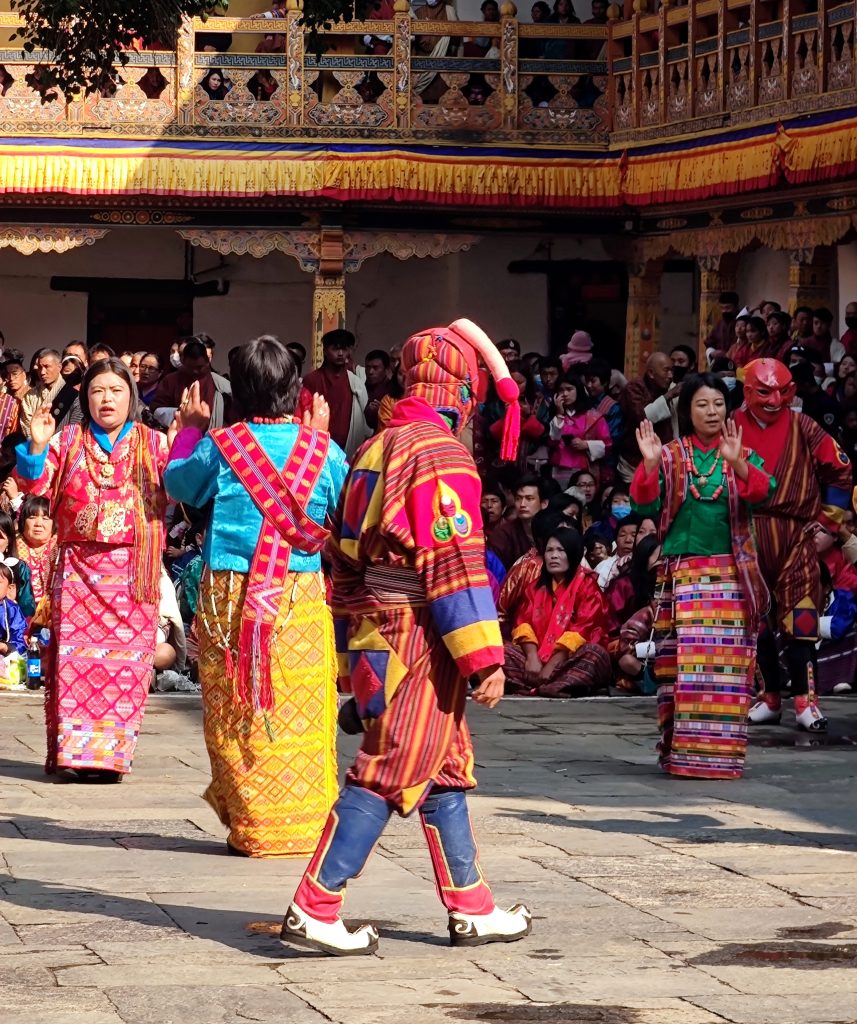
Surprisingly, these three masked men are not mere performers; they are dance instructors with an intimate knowledge of every move. Their entertaining presence extends beyond the performance, as they keenly observe each dancer, intervening when needed to ensure a seamless return to the choreography. This behind-the-scenes engagement adds an intriguing layer to the festivities, revealing a level of detail that escapes the notice of the casual observer.
The Bhutanese people have three types of dances – a slow one (dismissed as “especially boring”), followed by faster and modern dances. However, the first two are the only ones allowed at this festival to uphold tradition. As we witness the mesmerizing dances, we also explore the dzong, pondering whether to step over the imposing thresholds at the temples. Tradition dictates not to, as these thresholds are meant for demons and zombies incapable of lifting their legs, altering their trajectory upon impact.
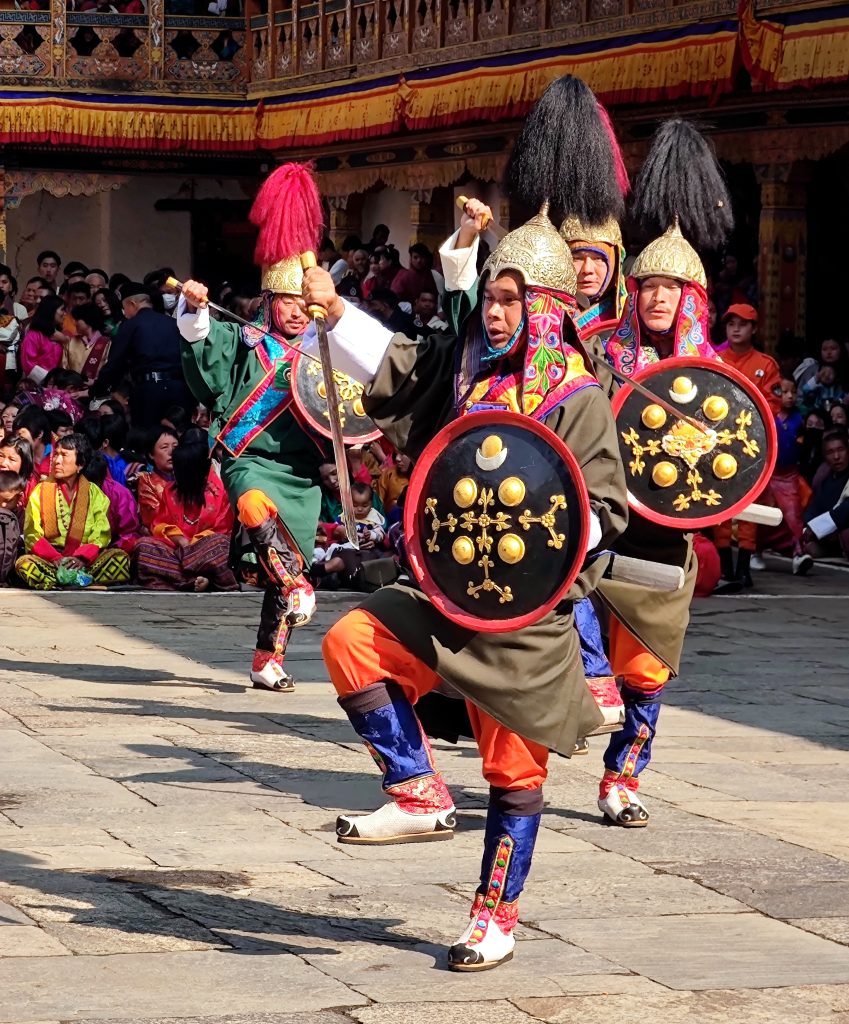
A Buddha statue graces the temple entrance, surrounded by depictions of Buddhism’s myriad stories. The early life of Buddha unfolds on the temple walls – born into royalty, sheltered from worldly suffering by his father, the king. Buddha’s enlightenment journey began when he encountered four people – a sick one, an old one, a dead body, and finally, a monk, who supposedly lived a life of solution to the suffering the first three experienced.
Buddha learned from various teachers, distinguishing effective from ineffective practices. For example, the teaching that one should eat only a grain of rice a day was not the right approach to meditation, because one needs a calm mind when meditating, which is disturbed by hunger.
During the pivotal moment of the Buddha’s enlightenment, a silent witness was lacking, prompting him to touch the earth with the fingers of his right hand, making the Earth God the observer. This explains the ubiquitous depiction in temples of the Buddha in this pose, symbolizing his connection to the Earth God, a figure of significance to the local community. Before any construction, a two-hour ritual unfolds, venerating the Earth God. This tradition ensures the longevity and safety of the structures, homes, or roads, even in a seismic-prone region. Consequently, in this land of earthquakes, buildings endure unscathed, a testament to the enduring reverence for the Earth God and the rituals performed before each endeavor. The temple houses not only Buddha but also the God of Gods, deciding when the next Buddha will arrive and when civilization will change.
The festival extends beyond dance rituals, featuring tents akin to a festival setup – offering food, drinks, and even gambling, allowed only on this occasion. My husband tries his hand at archery, a traditional Bhutanese sport. They boast an Olympic archery team, yet victory has eluded them. The chuckle of our guide reveals the amusing truth—locals are instilled with the philosophy from childhood: “Participation matters more than winning.”
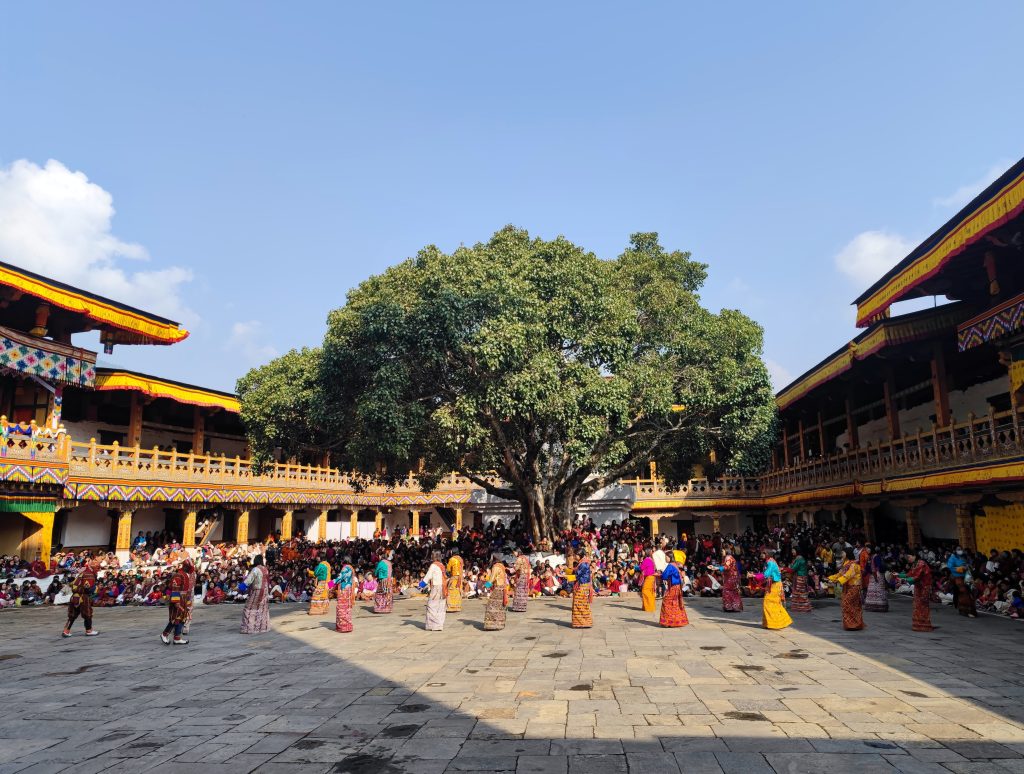
Moving forward, we traverse forests protected by strict rules prohibiting locals from cutting down trees without a special permit. Despite such efforts, the impact of global warming is palpable – milder winters and dwindling rivers mark the landscape. Our journey continues along winding roads. Our driver still hasn’t reached the impressive speed of 100 km/h which is the maximum he has ever driven in Bhutan. Time constraints prevent us from covering the entire route in one go, because of our commitment to keep teaching Chinese kids English online.
Back in Thimphu, our journey takes us to the Bhutan Post Office headquarters, where we encounter the world’s largest photo book and an enthralling collection of Bhutanese stamps. Here, we have the unique opportunity to create our personalized stamps. Thimphu’s history is fascinating; initially, it was covered in forests, and the government offered free land to locals to encourage settlement in the new capital. However, few accepted the offer at the time, not foreseeing the capital’s future value. Now, with Thimphu’s land being the most expensive, the irony isn’t lost on locals, who humorously reflect on the missed opportunity.
Our journey then takes us to Paro. On the way, a captivating legend surrounds a beautiful rock with a house in front of it. It is believed that the rock holds the energy of a failed attempt to transport treasures from India to Tibet, transforming into a cliff in Bhutan. Locals residing nearby are said to benefit from the lingering energy, ensuring prosperity and beauty for the inhabitants.
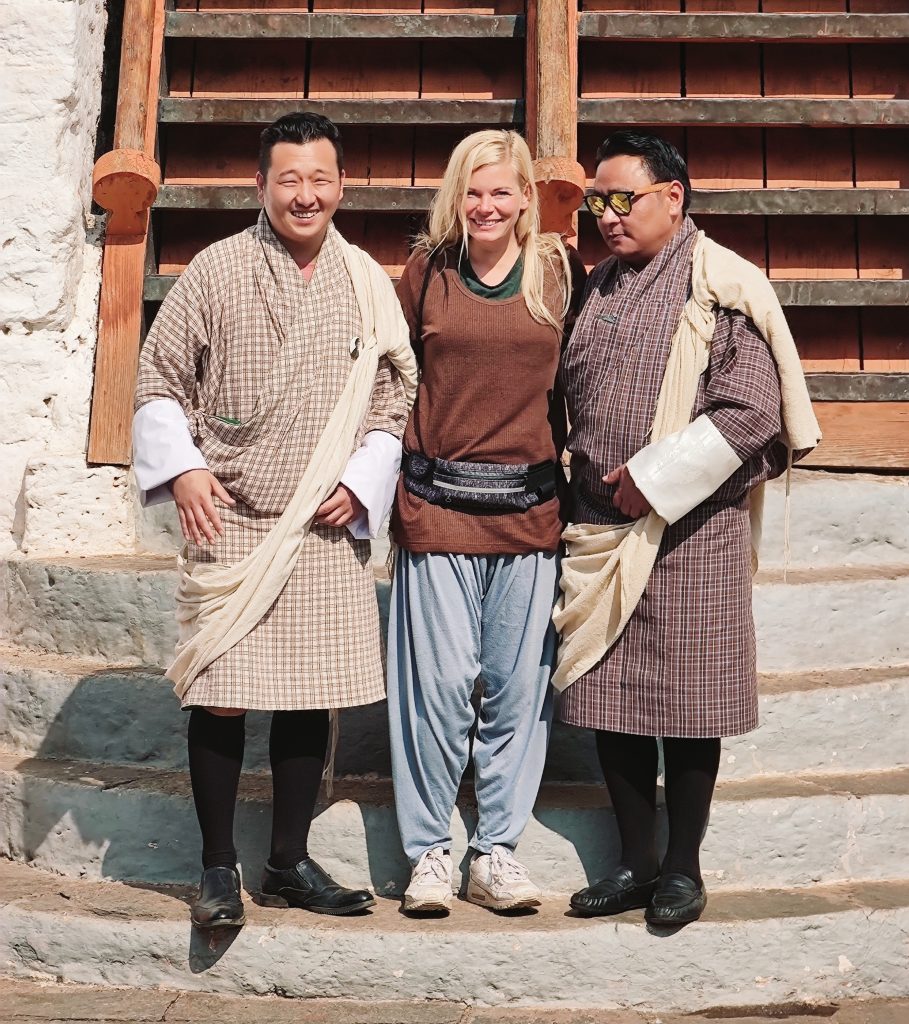
As we pass the military center, we learn that Bhutan has a modest army of only 10 thousand soldiers. A unique tradition is highlighted – only chief officers are allowed to ride horses, as riding on animals is generally not accepted in Bhutan.
Entering Paro, we hear tales of its residents’ once-stubborn reputation, with a saying advising against taking a spouse from Paro due to their perceived stubbornness. The region has its share of eccentricities, with neighboring villages known for walking with swords in the past, ready to use them if a visitor displeased them. The stories evoke laughter, a reminder of the wild days that Bhutan has transitioned from.
Passing by the country’s sole international airport, we are greeted by snow-capped mountain peaks in the distance. The day concludes with a sip of local whiskey, costing a mere four euros for a large bottle. To our surprise, we discover that our driver is not just a skilled guide behind the wheel; he is Bhutan’s archery champion. Fortunate with both our guide and driver, we revel in the warmth of Bhutan’s charm.
Get ready for the grand finale of our Bhutan journey in our upcoming articles!
